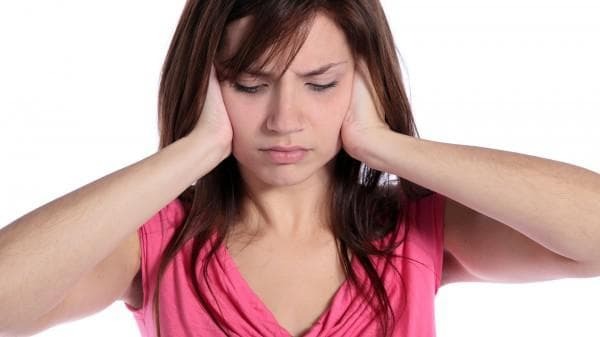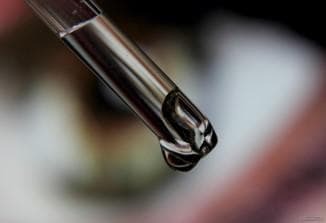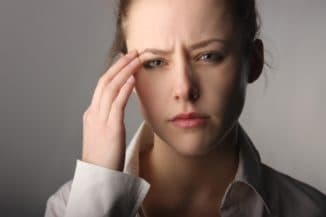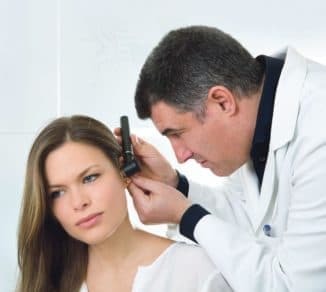
Otitis in an adult human has an infectious nature, this is the main criterion in the choice of therapy. Antibacterial drugs are prescribed on the basis of the results of the sowing tank, their choice is formed based on the age of the patient, the stage of the disease, its localization. The main goal of such treatment is to eliminate the cause of inflammation, to prevent irreversible changes in the hearing organs, to exclude the spread of pathogenic microflora in the body.
Contents
Otitis: types and symptoms
- 2.1 Types of drugs
- 2.2 Most popular antibiotics
- 2.3 Indications for use
- 2.4 Rules for the use of antibacterial drugs
Otitis: types and symptoms

Immobilizationand tinnitus - the characteristic signs of otitis
Inflammatory processes localized in any of the ear structures have a common name - otitis media. It can occur in the outer, middle or inner part of the organ, have an acute or chronic stage.
- Otitis externa may be independent or result from chronic purulent inflammation of the middle ear. The outer auditory canal is affected, the furuncle is often observed. Pain occurs when the jaw is stressed - chewing, talking.
- The cause of inflammation of the middle ear are bacteria, by penetration of which the nasopharynx serves. Less often the cause of infection is the rupture of the tympanic membrane. Acute stage of the disease begins with congestion, sensation of noise in the ears. When the symptoms of acute otitis increase, there is a sharp pain, the body temperature rises. The pain continues to intensify, gives in the teeth, jaw, neck. By this time, blood tests show obvious signs of inflammation. Perforation of the tympanic membrane occurs and the suppuration of their ear begins.
- Labyrinth occurs as a result of a bacterial infection or micro-injury. Its characteristic features include dizziness, imbalance. Hearing is reduced strongly, until complete deafness.
Any pain in the ear is a reason for visiting a doctor. Do not engage in self-medication at home, as most otitis require specific antibiotic therapy.
How to cure purulent otitis in infants, you can understand reading the article.
Any foreign substance introduced into the auditory can lead to an exacerbation of the disease, making the bacteria immune to the drug.
Application of antibiotics
Treatment of otitis is always a complex of measures. In the presence of exudate or purulent separable hygienic ENT procedures are required. External inflammation is treated with alcohol compresses, ear drops.
Types of drugs
 Antibiotics have a different form of release. In some cases, inflammation can be eliminated by applying only external means - drops and ointments. Ease of use allows for outpatient treatment.
Antibiotics have a different form of release. In some cases, inflammation can be eliminated by applying only external means - drops and ointments. Ease of use allows for outpatient treatment.
The tablet form of medications for the treatment of otitis is justified, when the patient's condition is of moderate severity, he can adequately take medicines, has no serious problems with gastrointestinal tract, chronic somatic diseases.
Taking antibiotics in the form of injections is prescribed at a severe stage of the disease, when it is necessary to quickly and effectively stop the inflammatory process, as well as to minimize the side effects of drugs.
The choice of the form of the medicine is carried out by the attending physician! Only on the basis of anamnesis and laboratory studies can you judge the effectiveness of a particular remedy.
After reading this article, you can understand how to effectively treat otitis media and what medicines need to be taken.
The most popular antibiotics
The standard of medical care recommends:
- amoxicillin;
- ceftriaxone;
- cefuroxime;
- azithromycin.

Azithromycin is one of the most commonly prescribed antibiotics for otitis
. If the otitis is accompanied by a fever, marked by an inflammatory process, staphylococci or streptococci are detected in bacteriological culture, and first-line preparations are prescribed - penicillins. They kill bacteria, affecting their shell. Trade names: Amoxicillin, EcoBall, Hiconcil, Flemoxin, Gonoform. If the otitis is chronic or the treatment does not bring results, amoxicillin together with clavulanic acid is prescribed( Augmentin, Amoxiclav).
What are the symptoms of acute otitis media, you can understand by reading this article.
When the action of penicillins is unsatisfactory, cephalosporins with a similar mechanism of action on bacteria are used. From this group of antibiotics for the treatment of otitis take drugs II and III generation, since IV and V are "heavy artillery", used for very persistent infections. Trade names: Ceftriaxone, Azaran, Biotrakson, Mediakson, Rocefin, Zinacef, Zinnat, Ketocef, Proxim.
Macrolides are used either when the listed drugs have not helped, or in combination with them. Drugs affect the proteins of microorganisms, stopping their reproduction. Trade names of medicines: Azithromycin, Azitral, Azitrox, Sumamed, Sumamox.
As a means for external use use a solution of antibiotics( Levomycetin, Normaks, Tsipromed), combined preparations containing glucocorticoids( Garazon, Anauran).
How is treated bilateral acute catarrhal otitis media, you can learn from this article.
Do not use antibiotics without doctor's advice! It is important to consider the patient's allergic sensitivity to the action of the drug. Systemic antibacterial agents are used only when it is impossible to establish an agent of otitis media.
Indications for use
 For external otitis, antibiotics may not be necessary. If the boil is opened in time and the infection does not get inside, you can limit yourself to compresses and ointments. In most cases, taking antibiotics is limited to instillation of the ears. These same measures can be taken in case of an easy otitis media of the middle ear. But if the patient has weak immunity, there are serious chronic diseases that contribute to the long course of the disease, then antibiotic therapy is indispensable.
For external otitis, antibiotics may not be necessary. If the boil is opened in time and the infection does not get inside, you can limit yourself to compresses and ointments. In most cases, taking antibiotics is limited to instillation of the ears. These same measures can be taken in case of an easy otitis media of the middle ear. But if the patient has weak immunity, there are serious chronic diseases that contribute to the long course of the disease, then antibiotic therapy is indispensable.
In the case of pregnancy or lactation, a thorough weighing of benefit and harm is practiced. If there is a threat of spread of infection, the onset of critical consequences, then taking antibacterial drugs is necessary. All of them penetrate the placental barrier and enter the breast milk, so in each specific case the most effective and safe preparation is selected.
How the external otitis treatment is treated with drops and which ones, it is possible to learn from this article.
Rules for the use of antibacterial drugs
The antibiotic of any group has an instruction manual, which must be followed impeccably!
 The dosage of the drug is determined by the attending physician. It depends on the causative agent of the disease, its severity, weight, height and age of the patient. A "shock dose" is prescribed only in the first 72 hours. If there was no relief, then you should change the form of the introduction. The duration of the medication is determined by clinical analysis, only with the onset of a stable remission is possible a change in the tactics of treatment. Most often, antibiotics are used for 7-10 days.
The dosage of the drug is determined by the attending physician. It depends on the causative agent of the disease, its severity, weight, height and age of the patient. A "shock dose" is prescribed only in the first 72 hours. If there was no relief, then you should change the form of the introduction. The duration of the medication is determined by clinical analysis, only with the onset of a stable remission is possible a change in the tactics of treatment. Most often, antibiotics are used for 7-10 days.
During treatment it is necessary to carefully monitor the manifestation of side effects. If they arise, inform the doctor about it. Often they are minor and do not require a change of treatment, but in some cases, a dose adjustment or a change of the drug is required. It is important to monitor liver and kidney function. When changing in laboratory tests, it is urgent to change the tactics of treatment.
The article describes the names of ear drops in otitis, which are the most effective.
Antibiotics belong to a group of conflict medications, so you need to carefully study what they do not combine. Instructions for use contain a list of medications that should be limited or excluded. But there is often no indication of taking antibiotics and alcohol, dairy products and some juices. All penicillins are "afraid" of milk. Their joint reception leads to the fact that calcium does not allow the pills to "open up" in time and they pass through the digestive tract, without providing the required action. All antibacterial drugs are afraid of acid. Juices, vinegar and dry wine are destructive to them.
Consequences and complications of
 disease Otitis requires serious attitude. Not only is the disease itself unpleasant, it makes a person incapacitated for at least 10 days, so it still has a lot of negative consequences.
disease Otitis requires serious attitude. Not only is the disease itself unpleasant, it makes a person incapacitated for at least 10 days, so it still has a lot of negative consequences.
Bradyacuasia is on the first place among complications. The ear has a complex structure with a multitude of cavities and transitions, the inflammatory processes in which leads to a disruption in the perception of sounds. Inadequate treatment, the refusal to take antibiotics can develop mastoiditis( inflammation in the temporal bone), which often affects the jaw and salivary glands.
The most dangerous consequence of otitis occurs when an untreated infection penetrates the meninges, causing meningitis, hydrocephalus, encephalitis.
How the treatment of Adhesive otitis with folk remedies can be understood by reading the article.
Video
When should the otitis be treated with antibiotics? The detailed answer in the video:
Which antibiotics for otitis media of the middle ear in children are most often indicated in the article.
Antibiotic therapy for otitis should be treated as inevitable. These are the same medicines as many others. Under the supervision of a doctor, given the indications and contraindications, you can choose a suitable tool that will successfully cope with the problem and not harm the body. Taking antibiotics "not on business", as well as not treating otitis at all - is the way to serious complications.
